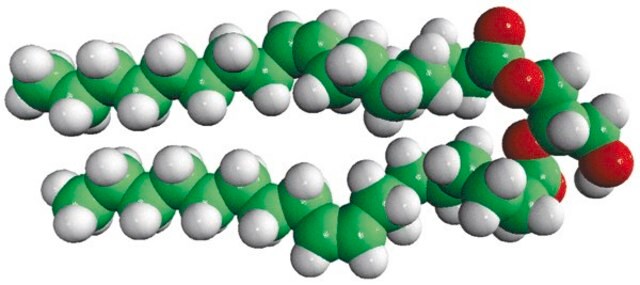800819C
Avanti
18:0-22:6 DG
1-stearoyl-2-docosahexaenoyl-sn-glycerol, chloroform
Sinónimos:
1-octadecanoyl-2-(4Z,7Z,10Z,13Z,16Z,19Z-docosahexaenoyl)-sn-glycerol; DG(18:0/22:6(4Z,7Z,10Z,13Z,16Z,19Z)/0:0)
About This Item
Productos recomendados
assay
>99% (TLC)
form
liquid
packaging
pkg of 1 × 5 mL (800819C-10mg)
manufacturer/tradename
Avanti Research™ - A Croda Brand 800819C
concentration
2 mg/mL (800819C-10mg)
lipid type
neutral lipids
neutral glycerides
shipped in
dry ice
storage temp.
−20°C
Categorías relacionadas
General description
Diacylglycerol mimicks the effects of the tumor-promoting compounds phorbol esters.
Application
- in the preparation of Golgi-like liposomes
- to study its effect on conventional protein kinase C (cPKC) and novel protein kinase C (nPKC) isozymes in vitro
- as a substrate for the measurement of diacylglycerol kinase η1 (DGKη1) activity in vitro
Packaging
Storage and Stability
Other Notes
Dry samples of diacylglycerol in chloroform, using a stream of nitrogen. Dissolve the residue in an appropriate volume of ethanol or DMSO, then dilute to the desired aqueous medium.
Most biological responses saturate at 20 to 250 μM sn-1,2-dioctanoylglycerol. Only sn-1,2 isomers appear to be active.
Legal Information
signalword
Danger
Hazard Classifications
Acute Tox. 3 Inhalation - Acute Tox. 4 Oral - Aquatic Chronic 3 - Carc. 2 - Eye Irrit. 2 - Repr. 2 - Skin Irrit. 2 - STOT RE 1 - STOT SE 3
target_organs
Central nervous system, Liver,Kidney
wgk_germany
WGK 3
Certificados de análisis (COA)
Busque Certificados de análisis (COA) introduciendo el número de lote del producto. Los números de lote se encuentran en la etiqueta del producto después de las palabras «Lot» o «Batch»
¿Ya tiene este producto?
Encuentre la documentación para los productos que ha comprado recientemente en la Biblioteca de documentos.
Nuestro equipo de científicos tiene experiencia en todas las áreas de investigación: Ciencias de la vida, Ciencia de los materiales, Síntesis química, Cromatografía, Analítica y muchas otras.
Póngase en contacto con el Servicio técnico









